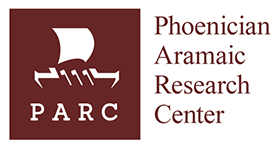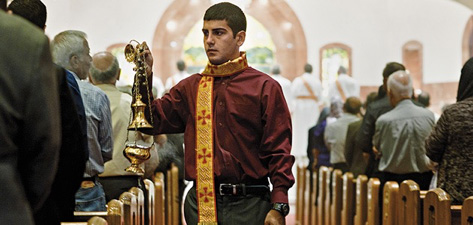By Ariel Sabar Smithsonian magazine, February 2013
It was a sunny morning in May, and I was in a car with a linguist and a tax preparer trolling the suburbs of Chicago for native speakers of Aramaic, the 3,000-year-old language of Jesus.
The linguist, Geoffrey Khan of the University of Cambridge, was nominally in town to give a speech at Northwestern University, in Evanston. But he had another agenda: Chicago’s northern suburbs are home to tens of thousands of Assyrians, Aramaic-speaking Christians driven from their Middle Eastern homelands by persecution and war. The Windy City is a heady place for one of the world’s foremost scholars of modern Aramaic, a man bent on documenting all of its dialects before the language—once the tongue of empires—follows its last speakers to the grave.
The tax preparer, Elias Bet-shmuel, a thickset man with a shiny pate, was a local Assyrian who had offered to be our sherpa. When he burst into the lobby of Khan’s hotel that morning, he announced the stops on our two-day trek in the confidential tone of a smuggler inventorying the contents of a shipment.
“I got Shaqlanaye, I have Bebednaye.” He was listing immigrant families by the names of the northern Iraqi villages whose dialects they spoke. Several of the families, it turned out, were Bet-shmuel’s clients.
As Bet-shmuel threaded his Infiniti sedan toward the nearby town of Niles, Illinois, Khan, a rangy 55-year-old, said he was on safari for speakers of “pure” dialects: Aramaic as preserved in villages, before speakers left for big, polyglot cities or, worse, new countries. This usually meant elderly folk who had lived the better part of their lives in mountain enclaves in Iraq, Syria, Iran or Turkey. “The less education the better,” Khan said. “When people come together in towns, even in Chicago, the dialects get mixed. When people get married, the husband’s and wife’s dialects converge.”
We turned onto a grid of neighborhood streets, and Bet-shmuel announced the day’s first stop: a 70-year-old widow from Bebede who had come to Chicago just a decade earlier. “She is a housewife with an elementary education. No English.”
Khan beamed. “I fall in love with these old ladies,” he said.
***
Aramaic, a Semitic language related to Hebrew and Arabic, was the common tongue of the entire Middle East when the Middle East was the crossroads of the world. People used it for commerce and government across territory stretching from Egypt and the Holy Land to India and China. Parts of the Bible and the Jewish Talmud were written in it; the original “writing on the wall,” presaging the fall of the Babylonians, was composed in it. As Jesus died on the cross, he cried in Aramaic, “Elahi, Elahi, lema shabaqtani?” (“My God, my God, why have you forsaken me?”)
But Aramaic is down now to its last generation or two of speakers, most of them scattered over the past century from homelands where their language once flourished. In their new lands, few children and even fewer grandchildren learn it. (My father, a Jew born in Kurdish Iraq, is a native speaker and scholar of Aramaic; I grew up in Los Angeles and know just a few words.) This generational rupture marks a language’s last days. For field linguists like Khan, recording native speakers—“informants,” in the lingo—is both an act of cultural preservation and an investigation into how ancient languages shift and splinter over time.
In a highly connected global age, languages are in die-off. Fifty to 90 percent of the roughly 7,000 languages spoken today are expected to go silent by century’s end. We live under an oligarchy of English and Mandarin and Spanish, in which 94 percent of the world’s population speaks 6 percent of its languages. Yet among threatened languages, Aramaic stands out. Arguably no other still-spoken language has fallen farther.
Its first speakers, the Arameans, were desert nomads. (The Bible describes the mythic forebear of the Hebrews as “a wandering Aramean.”) Spreading out from ancient Syria, they so blanketed Mesopotamia that when the Assyrians conquered the Middle East in the eighth century B.C., they adopted Aramaic—not their own tongue, Akkadian—as a language of empire. So did the Babylonians when they vanquished the Assyrians, and the Persians when they toppled the Babylonians. The language crossed the lips of Christians, Jews, Mandeans, Manicheans, Muslims, Samaritans, Zoroastrians and pagans.
The writing on the wall (the proverbial sort) came for Aramaic in the seventh century A.D., when Muslim armies from Arabia conquered the Middle East, and Arabic routed Aramaic as the region’s lingua franca. Aramaic survived only in the Kurdish mountains of Turkey, Iraq, Iran and Syria, places so remote they never got the memo. Jews and Christians there (though not Muslims, who spoke Kurdish) kept up Aramaic as an everyday tongue for another 1,300 years.
The number of Aramaic speakers alive today is difficult to calculate. Though some estimates set the figure as high as a half-million, that number is misleading. Because of its ancient lineage, lack of standardization and the isolation of speakers from one another, the modern tongue, known as Neo-Aramaic, has more than 100 dialects, most with no written analogue. Many dialects are already extinct, and others are down to their last one or two speakers.
As an everyday language, linguists told me, Aramaic is safe now in only one place: the Christian village of Maaloula, in the hills outside Damascus, where, with Syrian state support, elders still teach it to children.
***
Like many Neo-Aramaic experts, Khan, whose accent bears traces of his working-class childhood in northeast England, stumbled on the field almost by accident. In his early years at Cambridge, he worked on a trove of ancient Jewish manuscripts—in Hebrew, Arabic and Aramaic—known as the Cairo Geniza. But the long hours squinting at microfilm were a downer. Eager for change after a dispiriting day in a Jerusalem microfiche lab in the early 1990s, he asked a local organization of Kurdish Jews for referrals to actual native speakers of Aramaic.
No sooner had Khan sat down with a Jew from Erbil, a northern Iraqi city whose Aramaic dialect was undescribed, than he felt he had found his calling. “It completely blew my mind,” he told me. “To discover a living language through the lips of a living person, it was just incredibly exhilarating.”
The traditional aim of fieldwork is to produce for undocumented languages what linguists sometimes call “the holy trinity”: a grammar, which is a road map to sounds, syntax and structure; texts, which are chunks of unedited speech that reveal a language’s texture; and a dictionary. Over the past two decades, Khan has published highly regarded grammars on the previously undocumented dialects of Barwar, Qaraqosh, Erbil, Sulemaniyya and Halabja, all areas in Iraq, and Urmi and Sanandaj, in Iran. He is also at work on a web-based database of text and audio recordings that allows word-by-word comparisons across dozens of Aramaic dialects.
Aramaic speakers tend to greet microphone-toting linguists with traditional Middle Eastern hospitality. The widow we visited in Niles, Agnes Nissan Esho, would not let us leave before serving an elaborate lunch of kubba hamuth (sour dumplings), masta (yogurt), chicken with rice, and kadeh (spiced-walnut pastry).
“I’m getting very excited about some vowels here,” Khan said as Esho carried in the steaming plates of food.
“And I’m getting excited about the kadeh,” Bet-shmuel deadpanned.
The half-dozen Neo-Aramaic linguists I spoke with said informants often served feasts, confided family gossip and plied them with take-home boxes of fruit. But some are puzzled by the outside interest in their language, and others suspicious that their interlocutors are spies.
And bum steers abound. On our drive to one informant’s house, Khan told a story about his multiyear search for a Chicago man from Iraq’s Barwar region who had been described to him as a font of Assyrian folklore. “When we finally met, I said, ‘I heard you know lots of stories.’”
The man’s response: “I’ve forgotten them all.”
When we arrived at homes around Chicago, Khan, in dress shirt and blazer, explained his research, then drew from his backpack a digital voice recorder, a microphone and a sprawling loose-leaf questionnaire. Each session lasted two or three hours, as Khan worked, like an archaeologist with a soil sifter, to tease out nuances, among dialects, in pronunciation, vocabulary and grammar.
How would you say, “There they are”? he asked. How about, “Here I am”? How about, “He wants to come”? And on it went: “You want to come. I want to come. Come!”
To make sure he heard words correctly, Khan repeated them slowly. He held his mouth open an extra second to verify a vowel or ran a finger over his Adam’s apple to confirm a guttural.
At a public housing tower, we spent more than an hour with a 97-year-old Assyrian from Turkey and his 90-year-old wife. When we stopped for coffee afterward, I asked Khan whether he’d found the meeting productive. “Some pronunciations of one of the consonants in the word for ‘hen’ are not according to what I predicted,” he said.
Advances in field linguistics, I saw, come in dribs and drabs, not eurekas.
The work has its exhilarating days, though, and few moved Khan more than his 2008 trip to the former Soviet republic of Georgia. He was in the capital of Tbilisi in search of Aramaic speakers from Salamas, a city in northwestern Iran. One wave of Assyrians fled Salamas after a Kurdish chieftain murdered a Church of the East patriarch there in 1918; another, after an earthquake a dozen years later.
In Tbilisi, people told Khan that all but three of the dialect’s “pure” speakers had died. At the first house, the man’s daughter apologized: Her father had recently suffered a stroke and was mute. At the second, an older woman lived with a quartet of energetic Rottweilers. “I took out my microphone and they just started howling and barking,” Khan recalled. “It was impossible.”
Finally, a local Assyrian escorted Khan one night into an imposing Soviet-era apartment block. At the top of a dark flight of stairs was a one-room apartment. A frail woman in her mid-90s answered the door.
Khan looked at her brittle physique and wondered how much she could handle. He told himself he would stay for just a few minutes. But when he got up to leave, the woman stretched a bony hand across the table and clasped his wrist.
“Biqir, Biqir,” she pleaded, in a small voice. (“Ask, ask.”)
“She literally grabbed onto me,” he said. “It was as if this was her last breath and she wanted to tell me everything.”
For two hours she hung on his wrist as his recorder filled with the sounds of a language in twilight.
Source: Smithsonian.com

